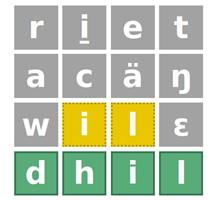Surrey Morphology Group
Surrey Morphology Group (SMG) is a linguistics research centre dedicated to the study of language diversity and its theoretical consequences.
Our research combines the investigation of grammatical categories in a broad sample of languages with the use of explicit formal and statistical frameworks for the expression of typological and theoretical generalizations.
SMG has received funding from the European Research Council, the Economic and Social Research Council, the Arts and Humanities Research Council, the British Academy and the Leverhulme Trust, among others.
A suite of experiments, with speakers of six Oceanic languages, spoken in Vanuatu and New Caledonia, show how apparently useful distinctions in language may become fixed.
Find archived data from our databases on our Zenodo community, a multi-disciplinary open repository maintained by CERN.
Paralex is a standard for morphological lexicons which document inflectional paradigms. It strives to provide data following ethical data management principles.
These interactive visualisations of Skolt Saami verbs showcase how technology can aid us in viewing – and understanding – complex linguistic data.
A lexical split is an inconsistency in the paradigm of an inflected word. Lexemes may exhibit a single split, or multiple cross-cutting splits.
These interactive visualisations of Chichimec verbs showcase how technology can aid us in viewing – and understanding – complex linguistic data.
Nuer is a Nilo-Saharan language spoken in South Sudan and Ethiopia. Nuer Lexicon is the first interactive online dictionary of this major language of East Africa.
A Prominent Internal Possessor or PIP is a noun phrase internal possessor that behaves, fully or partially, as if it were a clause-level element and the head of its own phrase.
This multimedia corpus of original audio and video texts in several minority languages documents a wide range of phenomena from Siberian languages and cultures.
This exhibition of pictures and cultural artefacts from Kilivila and Mian explores the threatened cultures and categorisation systems of two endangered languages.
The inflectional morphology of Oto-Manguean languages can be realised by a rich array of morphological forms within a single word, resulting in highly complex systems.
Morphological systems introduce a layer of structure between meaning and its expression attaining in some languages an astonishing degree of complexity.
The online version of the Archi dictionary contains sound files, digital pictures of culturally significant objects, idioms and example sentences with interlinear glossing.
Elicited and spontaneous examples from SENĆOŦEN, the language of the Saanich people, are organised according to their role as sentences, verbs or roots.
Features are fundamental components of linguistic description that have proven invaluable for conducting grammatical analysis and linguistic theorising.
Possessive morphology is used as a source of subject-indexing marking actors or agents in the languages surrounding the Bougainville region of Papua New Guinea.
Periphrasis reveals how meaning is apportioned between morphology ('bright' and 'brighter') and syntax ('intelligent' and 'more intelligent').
The term 'defectiveness' refers to gaps in inflectional paradigms that do not appear to follow from natural restrictions imposed by meaning or function.
Short term morphosyntactic change concerns changes in the use of forms in a short period of time even when the forms themselves have changed relatively little.
Deponency is the term used to describe mismatches that occur when a word form is used in some function incompatible with its normal function.
Suppletion is a morphological phenomenon where different inflectional forms of the same sign are maximally regular in their semantics, yet maximally irregular in form.
Agreement is the expression of grammatical information in the ‘wrong place’: a relation that can be described in terms of controllers, targets, domains and conditions.
Person syncretism occurs when two or more person values are represented by a single form in the inflectional paradigm for agreement with an argument on verbs.
The term 'syncretism' refers to the phenomenon whereby a single form fulfils two or more different functions in the within the inflectional morphology of a language.
Archidle & Nuerdle
Surrey Morphology Group have created wordle games for the Archi and Nuer languages. Play it and share your results on twitter @surreysmg !
MORPH: A blog
MORPH is a blog about languages and linguistic history published by members of the Surrey Morphology Group.












